Report: Managing Communication, Knowledge, and Information for ASUS
VerifiedAdded on 2020/07/22
|20
|6094
|182
Report
AI Summary
This report provides a comprehensive analysis of managing communication, knowledge, and information for ASUS, a major software and hardware manufacturer. The report begins with an introduction that highlights the significance of effective communication, knowledge, and information management in the context of ASUS's marketing efforts, particularly through its partnership with J. Walter Thompson (JWT). Task 1 examines the range of decisions JWT must make, the information and knowledge required for effective decision-making, and the internal and external sources of information available to support these decisions. Task 2 focuses on stakeholder management, including identifying stakeholders, developing relationships, and involving them in decision-making processes. Task 3 assesses the existing communication processes within the agency, suggests ways to improve communication systems, and outlines strategies for integrating these systems. Finally, Task 4 explores approaches to collecting, formatting, storing, and disseminating information and knowledge, along with recommendations for improvements and a strategy to enhance access to information systems. The report concludes with a summary of key findings and recommendations for ASUS to improve its communication and information management practices.
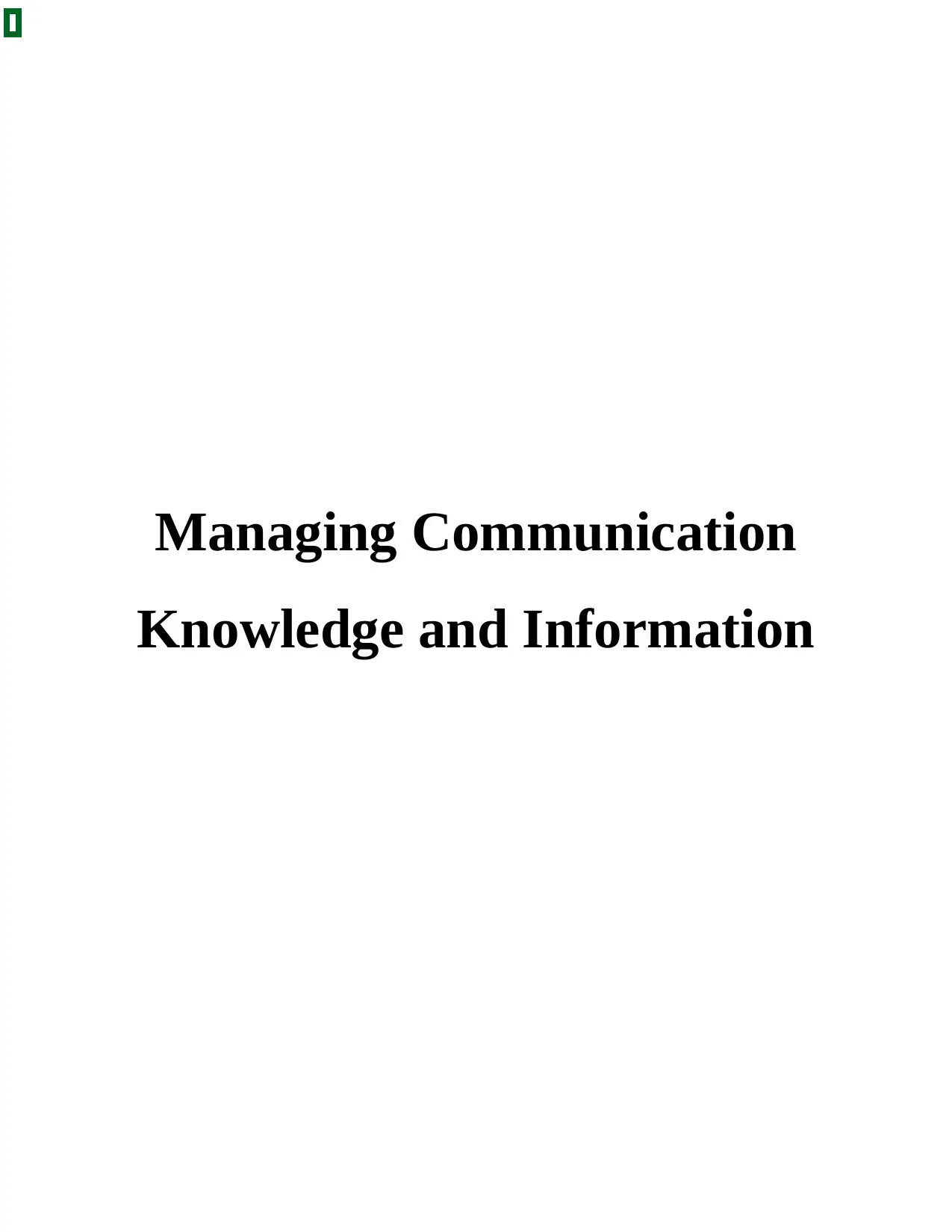
Managing Communication
Knowledge and Information
Knowledge and Information
Paraphrase This Document
Need a fresh take? Get an instant paraphrase of this document with our AI Paraphraser
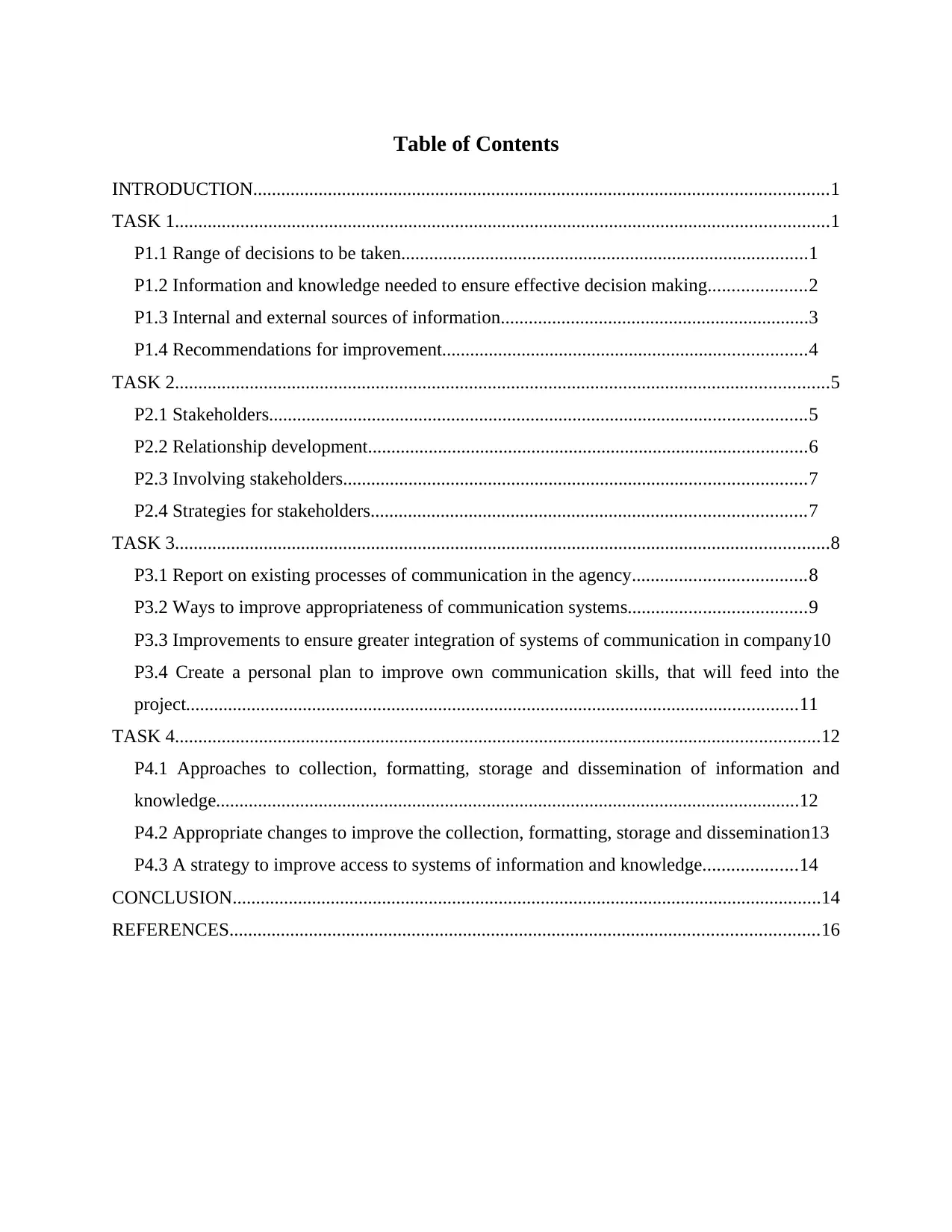
Table of Contents
INTRODUCTION...........................................................................................................................1
TASK 1............................................................................................................................................1
P1.1 Range of decisions to be taken.......................................................................................1
P1.2 Information and knowledge needed to ensure effective decision making.....................2
P1.3 Internal and external sources of information..................................................................3
P1.4 Recommendations for improvement..............................................................................4
TASK 2............................................................................................................................................5
P2.1 Stakeholders...................................................................................................................5
P2.2 Relationship development..............................................................................................6
P2.3 Involving stakeholders...................................................................................................7
P2.4 Strategies for stakeholders.............................................................................................7
TASK 3............................................................................................................................................8
P3.1 Report on existing processes of communication in the agency.....................................8
P3.2 Ways to improve appropriateness of communication systems......................................9
P3.3 Improvements to ensure greater integration of systems of communication in company10
P3.4 Create a personal plan to improve own communication skills, that will feed into the
project...................................................................................................................................11
TASK 4..........................................................................................................................................12
P4.1 Approaches to collection, formatting, storage and dissemination of information and
knowledge.............................................................................................................................12
P4.2 Appropriate changes to improve the collection, formatting, storage and dissemination13
P4.3 A strategy to improve access to systems of information and knowledge....................14
CONCLUSION..............................................................................................................................14
REFERENCES..............................................................................................................................16
INTRODUCTION...........................................................................................................................1
TASK 1............................................................................................................................................1
P1.1 Range of decisions to be taken.......................................................................................1
P1.2 Information and knowledge needed to ensure effective decision making.....................2
P1.3 Internal and external sources of information..................................................................3
P1.4 Recommendations for improvement..............................................................................4
TASK 2............................................................................................................................................5
P2.1 Stakeholders...................................................................................................................5
P2.2 Relationship development..............................................................................................6
P2.3 Involving stakeholders...................................................................................................7
P2.4 Strategies for stakeholders.............................................................................................7
TASK 3............................................................................................................................................8
P3.1 Report on existing processes of communication in the agency.....................................8
P3.2 Ways to improve appropriateness of communication systems......................................9
P3.3 Improvements to ensure greater integration of systems of communication in company10
P3.4 Create a personal plan to improve own communication skills, that will feed into the
project...................................................................................................................................11
TASK 4..........................................................................................................................................12
P4.1 Approaches to collection, formatting, storage and dissemination of information and
knowledge.............................................................................................................................12
P4.2 Appropriate changes to improve the collection, formatting, storage and dissemination13
P4.3 A strategy to improve access to systems of information and knowledge....................14
CONCLUSION..............................................................................................................................14
REFERENCES..............................................................................................................................16
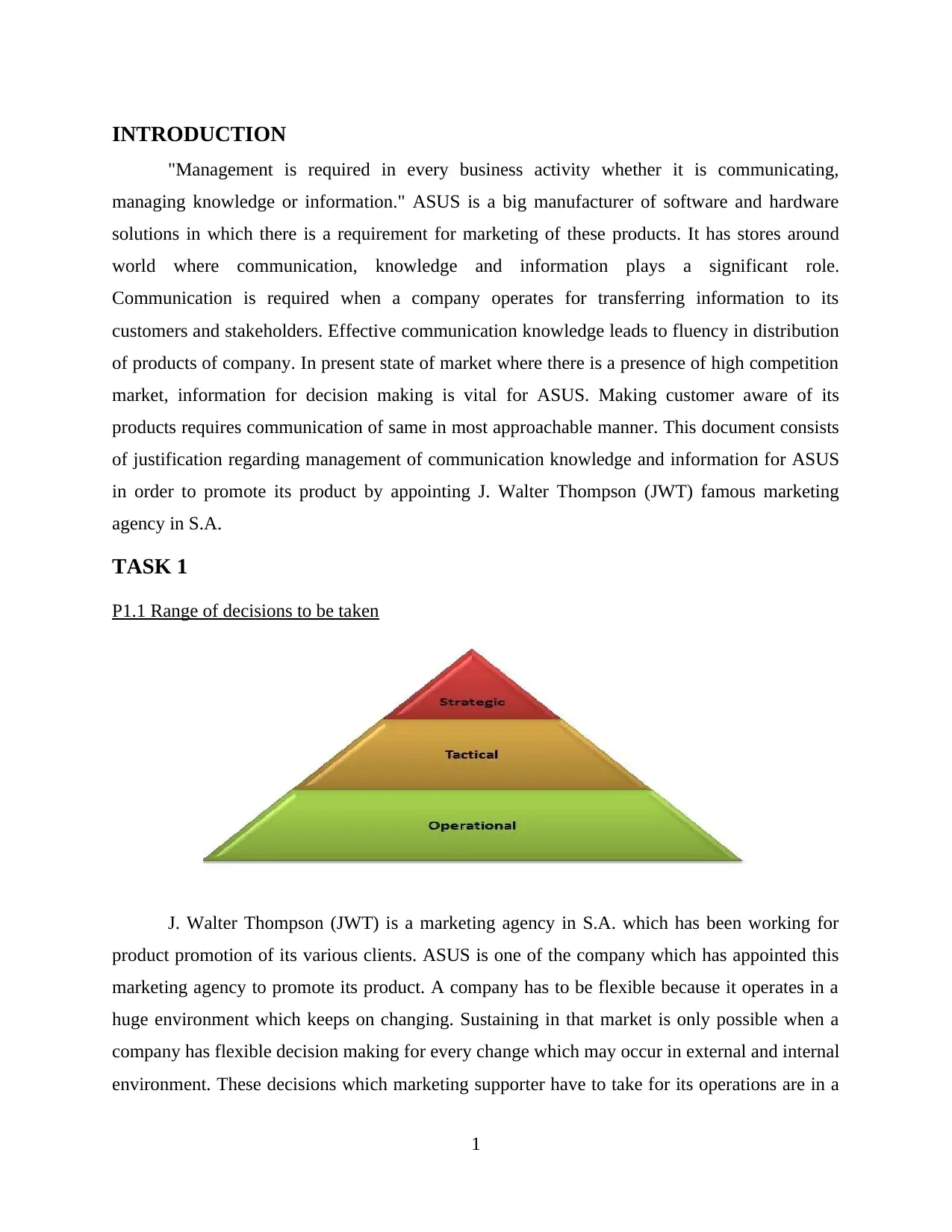
INTRODUCTION
"Management is required in every business activity whether it is communicating,
managing knowledge or information." ASUS is a big manufacturer of software and hardware
solutions in which there is a requirement for marketing of these products. It has stores around
world where communication, knowledge and information plays a significant role.
Communication is required when a company operates for transferring information to its
customers and stakeholders. Effective communication knowledge leads to fluency in distribution
of products of company. In present state of market where there is a presence of high competition
market, information for decision making is vital for ASUS. Making customer aware of its
products requires communication of same in most approachable manner. This document consists
of justification regarding management of communication knowledge and information for ASUS
in order to promote its product by appointing J. Walter Thompson (JWT) famous marketing
agency in S.A.
TASK 1
P1.1 Range of decisions to be taken
J. Walter Thompson (JWT) is a marketing agency in S.A. which has been working for
product promotion of its various clients. ASUS is one of the company which has appointed this
marketing agency to promote its product. A company has to be flexible because it operates in a
huge environment which keeps on changing. Sustaining in that market is only possible when a
company has flexible decision making for every change which may occur in external and internal
environment. These decisions which marketing supporter have to take for its operations are in a
1
"Management is required in every business activity whether it is communicating,
managing knowledge or information." ASUS is a big manufacturer of software and hardware
solutions in which there is a requirement for marketing of these products. It has stores around
world where communication, knowledge and information plays a significant role.
Communication is required when a company operates for transferring information to its
customers and stakeholders. Effective communication knowledge leads to fluency in distribution
of products of company. In present state of market where there is a presence of high competition
market, information for decision making is vital for ASUS. Making customer aware of its
products requires communication of same in most approachable manner. This document consists
of justification regarding management of communication knowledge and information for ASUS
in order to promote its product by appointing J. Walter Thompson (JWT) famous marketing
agency in S.A.
TASK 1
P1.1 Range of decisions to be taken
J. Walter Thompson (JWT) is a marketing agency in S.A. which has been working for
product promotion of its various clients. ASUS is one of the company which has appointed this
marketing agency to promote its product. A company has to be flexible because it operates in a
huge environment which keeps on changing. Sustaining in that market is only possible when a
company has flexible decision making for every change which may occur in external and internal
environment. These decisions which marketing supporter have to take for its operations are in a
1
⊘ This is a preview!⊘
Do you want full access?
Subscribe today to unlock all pages.

Trusted by 1+ million students worldwide
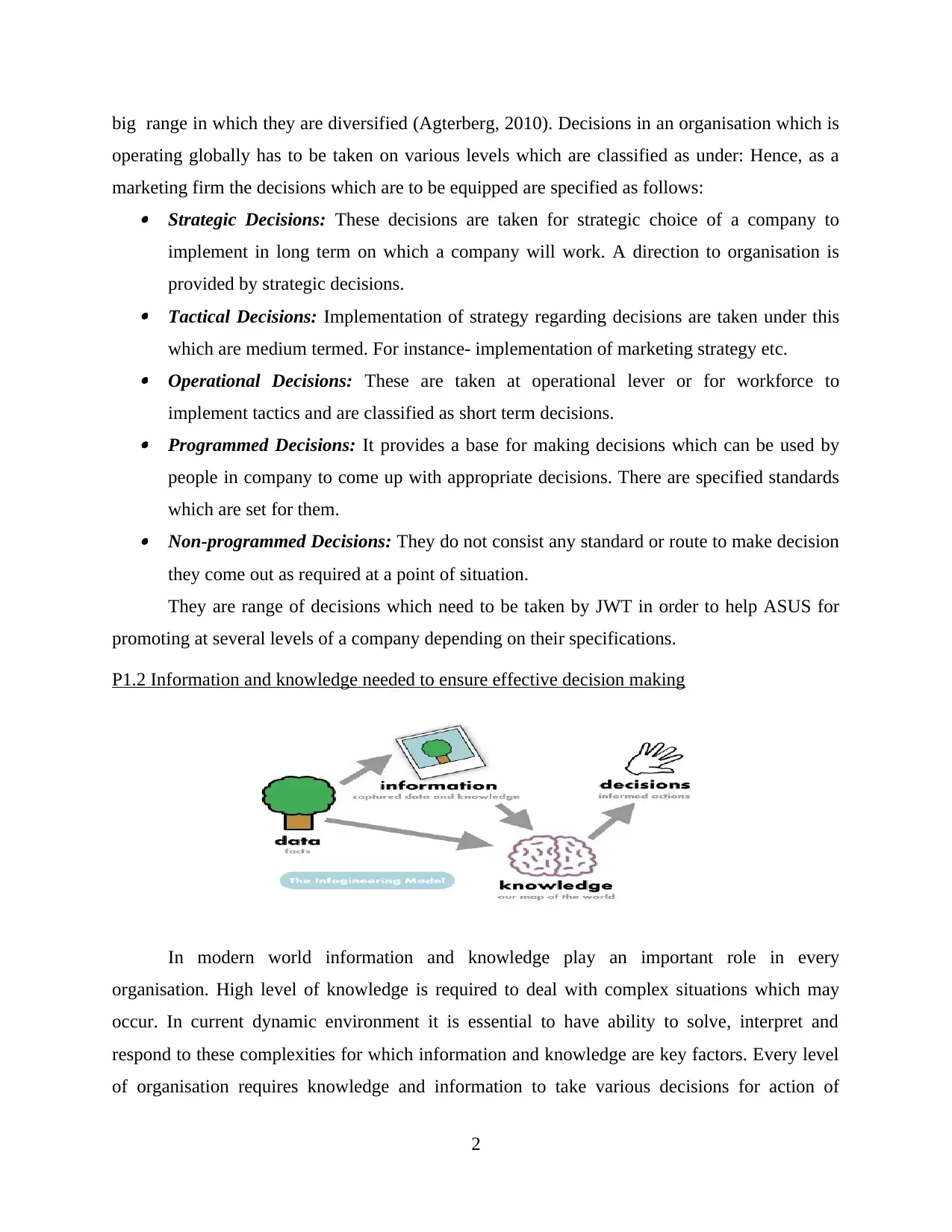
big range in which they are diversified (Agterberg, 2010). Decisions in an organisation which is
operating globally has to be taken on various levels which are classified as under: Hence, as a
marketing firm the decisions which are to be equipped are specified as follows: Strategic Decisions: These decisions are taken for strategic choice of a company to
implement in long term on which a company will work. A direction to organisation is
provided by strategic decisions. Tactical Decisions: Implementation of strategy regarding decisions are taken under this
which are medium termed. For instance- implementation of marketing strategy etc. Operational Decisions: These are taken at operational lever or for workforce to
implement tactics and are classified as short term decisions. Programmed Decisions: It provides a base for making decisions which can be used by
people in company to come up with appropriate decisions. There are specified standards
which are set for them. Non-programmed Decisions: They do not consist any standard or route to make decision
they come out as required at a point of situation.
They are range of decisions which need to be taken by JWT in order to help ASUS for
promoting at several levels of a company depending on their specifications.
P1.2 Information and knowledge needed to ensure effective decision making
In modern world information and knowledge play an important role in every
organisation. High level of knowledge is required to deal with complex situations which may
occur. In current dynamic environment it is essential to have ability to solve, interpret and
respond to these complexities for which information and knowledge are key factors. Every level
of organisation requires knowledge and information to take various decisions for action of
2
operating globally has to be taken on various levels which are classified as under: Hence, as a
marketing firm the decisions which are to be equipped are specified as follows: Strategic Decisions: These decisions are taken for strategic choice of a company to
implement in long term on which a company will work. A direction to organisation is
provided by strategic decisions. Tactical Decisions: Implementation of strategy regarding decisions are taken under this
which are medium termed. For instance- implementation of marketing strategy etc. Operational Decisions: These are taken at operational lever or for workforce to
implement tactics and are classified as short term decisions. Programmed Decisions: It provides a base for making decisions which can be used by
people in company to come up with appropriate decisions. There are specified standards
which are set for them. Non-programmed Decisions: They do not consist any standard or route to make decision
they come out as required at a point of situation.
They are range of decisions which need to be taken by JWT in order to help ASUS for
promoting at several levels of a company depending on their specifications.
P1.2 Information and knowledge needed to ensure effective decision making
In modern world information and knowledge play an important role in every
organisation. High level of knowledge is required to deal with complex situations which may
occur. In current dynamic environment it is essential to have ability to solve, interpret and
respond to these complexities for which information and knowledge are key factors. Every level
of organisation requires knowledge and information to take various decisions for action of
2
Paraphrase This Document
Need a fresh take? Get an instant paraphrase of this document with our AI Paraphraser
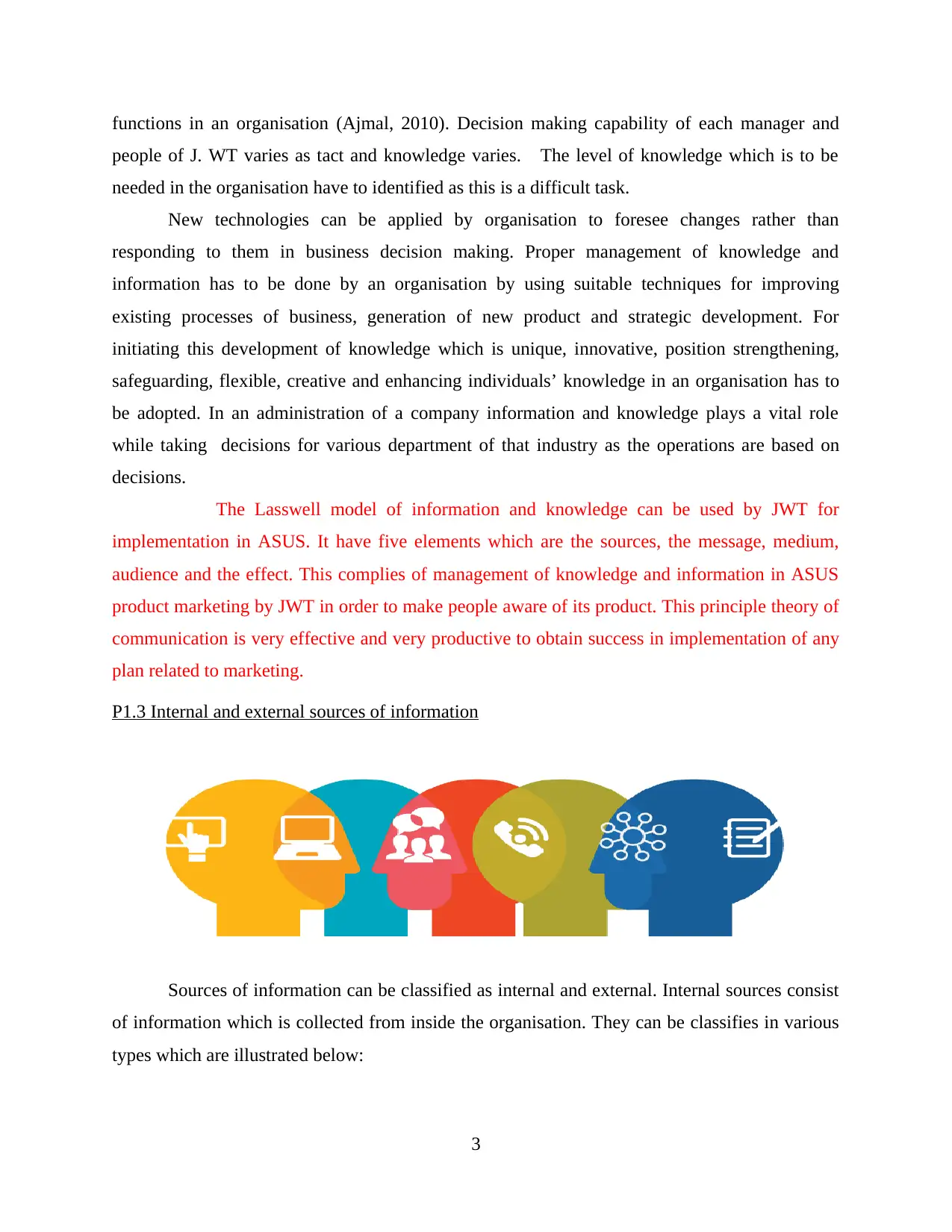
functions in an organisation (Ajmal, 2010). Decision making capability of each manager and
people of J. WT varies as tact and knowledge varies. The level of knowledge which is to be
needed in the organisation have to identified as this is a difficult task.
New technologies can be applied by organisation to foresee changes rather than
responding to them in business decision making. Proper management of knowledge and
information has to be done by an organisation by using suitable techniques for improving
existing processes of business, generation of new product and strategic development. For
initiating this development of knowledge which is unique, innovative, position strengthening,
safeguarding, flexible, creative and enhancing individuals’ knowledge in an organisation has to
be adopted. In an administration of a company information and knowledge plays a vital role
while taking decisions for various department of that industry as the operations are based on
decisions.
The Lasswell model of information and knowledge can be used by JWT for
implementation in ASUS. It have five elements which are the sources, the message, medium,
audience and the effect. This complies of management of knowledge and information in ASUS
product marketing by JWT in order to make people aware of its product. This principle theory of
communication is very effective and very productive to obtain success in implementation of any
plan related to marketing.
P1.3 Internal and external sources of information
Sources of information can be classified as internal and external. Internal sources consist
of information which is collected from inside the organisation. They can be classifies in various
types which are illustrated below:
3
people of J. WT varies as tact and knowledge varies. The level of knowledge which is to be
needed in the organisation have to identified as this is a difficult task.
New technologies can be applied by organisation to foresee changes rather than
responding to them in business decision making. Proper management of knowledge and
information has to be done by an organisation by using suitable techniques for improving
existing processes of business, generation of new product and strategic development. For
initiating this development of knowledge which is unique, innovative, position strengthening,
safeguarding, flexible, creative and enhancing individuals’ knowledge in an organisation has to
be adopted. In an administration of a company information and knowledge plays a vital role
while taking decisions for various department of that industry as the operations are based on
decisions.
The Lasswell model of information and knowledge can be used by JWT for
implementation in ASUS. It have five elements which are the sources, the message, medium,
audience and the effect. This complies of management of knowledge and information in ASUS
product marketing by JWT in order to make people aware of its product. This principle theory of
communication is very effective and very productive to obtain success in implementation of any
plan related to marketing.
P1.3 Internal and external sources of information
Sources of information can be classified as internal and external. Internal sources consist
of information which is collected from inside the organisation. They can be classifies in various
types which are illustrated below:
3
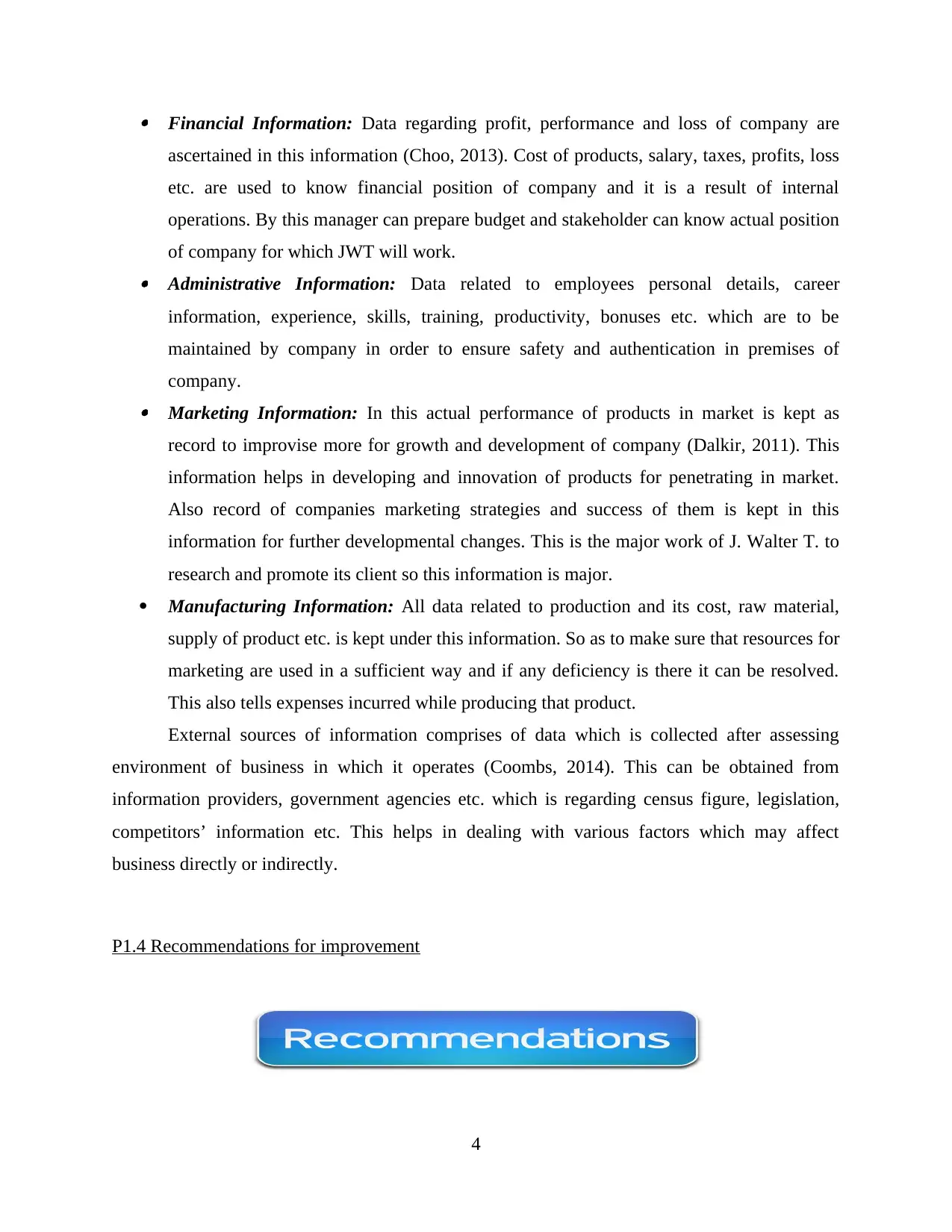
Financial Information: Data regarding profit, performance and loss of company are
ascertained in this information (Choo, 2013). Cost of products, salary, taxes, profits, loss
etc. are used to know financial position of company and it is a result of internal
operations. By this manager can prepare budget and stakeholder can know actual position
of company for which JWT will work. Administrative Information: Data related to employees personal details, career
information, experience, skills, training, productivity, bonuses etc. which are to be
maintained by company in order to ensure safety and authentication in premises of
company. Marketing Information: In this actual performance of products in market is kept as
record to improvise more for growth and development of company (Dalkir, 2011). This
information helps in developing and innovation of products for penetrating in market.
Also record of companies marketing strategies and success of them is kept in this
information for further developmental changes. This is the major work of J. Walter T. to
research and promote its client so this information is major.
Manufacturing Information: All data related to production and its cost, raw material,
supply of product etc. is kept under this information. So as to make sure that resources for
marketing are used in a sufficient way and if any deficiency is there it can be resolved.
This also tells expenses incurred while producing that product.
External sources of information comprises of data which is collected after assessing
environment of business in which it operates (Coombs, 2014). This can be obtained from
information providers, government agencies etc. which is regarding census figure, legislation,
competitors’ information etc. This helps in dealing with various factors which may affect
business directly or indirectly.
P1.4 Recommendations for improvement
4
ascertained in this information (Choo, 2013). Cost of products, salary, taxes, profits, loss
etc. are used to know financial position of company and it is a result of internal
operations. By this manager can prepare budget and stakeholder can know actual position
of company for which JWT will work. Administrative Information: Data related to employees personal details, career
information, experience, skills, training, productivity, bonuses etc. which are to be
maintained by company in order to ensure safety and authentication in premises of
company. Marketing Information: In this actual performance of products in market is kept as
record to improvise more for growth and development of company (Dalkir, 2011). This
information helps in developing and innovation of products for penetrating in market.
Also record of companies marketing strategies and success of them is kept in this
information for further developmental changes. This is the major work of J. Walter T. to
research and promote its client so this information is major.
Manufacturing Information: All data related to production and its cost, raw material,
supply of product etc. is kept under this information. So as to make sure that resources for
marketing are used in a sufficient way and if any deficiency is there it can be resolved.
This also tells expenses incurred while producing that product.
External sources of information comprises of data which is collected after assessing
environment of business in which it operates (Coombs, 2014). This can be obtained from
information providers, government agencies etc. which is regarding census figure, legislation,
competitors’ information etc. This helps in dealing with various factors which may affect
business directly or indirectly.
P1.4 Recommendations for improvement
4
⊘ This is a preview!⊘
Do you want full access?
Subscribe today to unlock all pages.

Trusted by 1+ million students worldwide
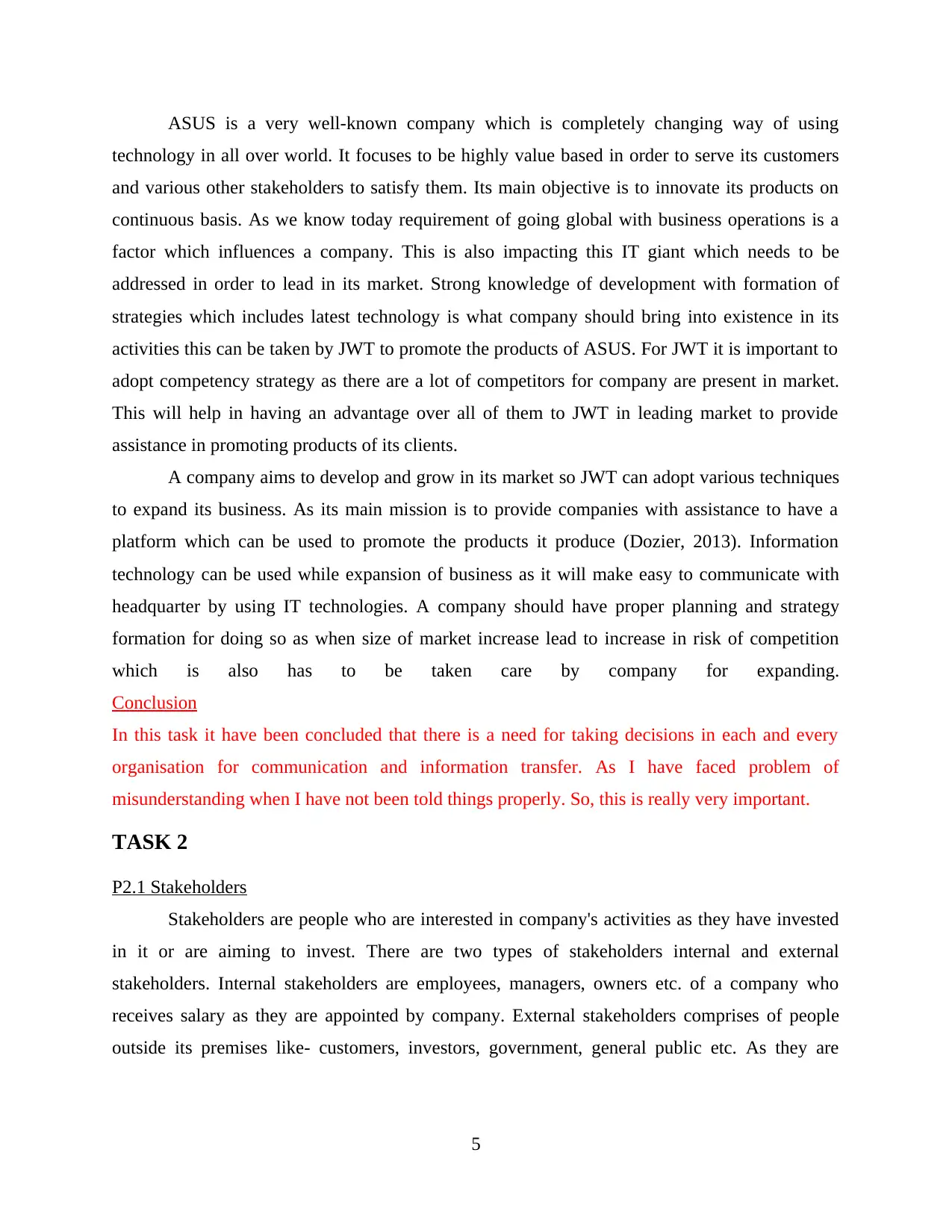
ASUS is a very well-known company which is completely changing way of using
technology in all over world. It focuses to be highly value based in order to serve its customers
and various other stakeholders to satisfy them. Its main objective is to innovate its products on
continuous basis. As we know today requirement of going global with business operations is a
factor which influences a company. This is also impacting this IT giant which needs to be
addressed in order to lead in its market. Strong knowledge of development with formation of
strategies which includes latest technology is what company should bring into existence in its
activities this can be taken by JWT to promote the products of ASUS. For JWT it is important to
adopt competency strategy as there are a lot of competitors for company are present in market.
This will help in having an advantage over all of them to JWT in leading market to provide
assistance in promoting products of its clients.
A company aims to develop and grow in its market so JWT can adopt various techniques
to expand its business. As its main mission is to provide companies with assistance to have a
platform which can be used to promote the products it produce (Dozier, 2013). Information
technology can be used while expansion of business as it will make easy to communicate with
headquarter by using IT technologies. A company should have proper planning and strategy
formation for doing so as when size of market increase lead to increase in risk of competition
which is also has to be taken care by company for expanding.
Conclusion
In this task it have been concluded that there is a need for taking decisions in each and every
organisation for communication and information transfer. As I have faced problem of
misunderstanding when I have not been told things properly. So, this is really very important.
TASK 2
P2.1 Stakeholders
Stakeholders are people who are interested in company's activities as they have invested
in it or are aiming to invest. There are two types of stakeholders internal and external
stakeholders. Internal stakeholders are employees, managers, owners etc. of a company who
receives salary as they are appointed by company. External stakeholders comprises of people
outside its premises like- customers, investors, government, general public etc. As they are
5
technology in all over world. It focuses to be highly value based in order to serve its customers
and various other stakeholders to satisfy them. Its main objective is to innovate its products on
continuous basis. As we know today requirement of going global with business operations is a
factor which influences a company. This is also impacting this IT giant which needs to be
addressed in order to lead in its market. Strong knowledge of development with formation of
strategies which includes latest technology is what company should bring into existence in its
activities this can be taken by JWT to promote the products of ASUS. For JWT it is important to
adopt competency strategy as there are a lot of competitors for company are present in market.
This will help in having an advantage over all of them to JWT in leading market to provide
assistance in promoting products of its clients.
A company aims to develop and grow in its market so JWT can adopt various techniques
to expand its business. As its main mission is to provide companies with assistance to have a
platform which can be used to promote the products it produce (Dozier, 2013). Information
technology can be used while expansion of business as it will make easy to communicate with
headquarter by using IT technologies. A company should have proper planning and strategy
formation for doing so as when size of market increase lead to increase in risk of competition
which is also has to be taken care by company for expanding.
Conclusion
In this task it have been concluded that there is a need for taking decisions in each and every
organisation for communication and information transfer. As I have faced problem of
misunderstanding when I have not been told things properly. So, this is really very important.
TASK 2
P2.1 Stakeholders
Stakeholders are people who are interested in company's activities as they have invested
in it or are aiming to invest. There are two types of stakeholders internal and external
stakeholders. Internal stakeholders are employees, managers, owners etc. of a company who
receives salary as they are appointed by company. External stakeholders comprises of people
outside its premises like- customers, investors, government, general public etc. As they are
5
Paraphrase This Document
Need a fresh take? Get an instant paraphrase of this document with our AI Paraphraser
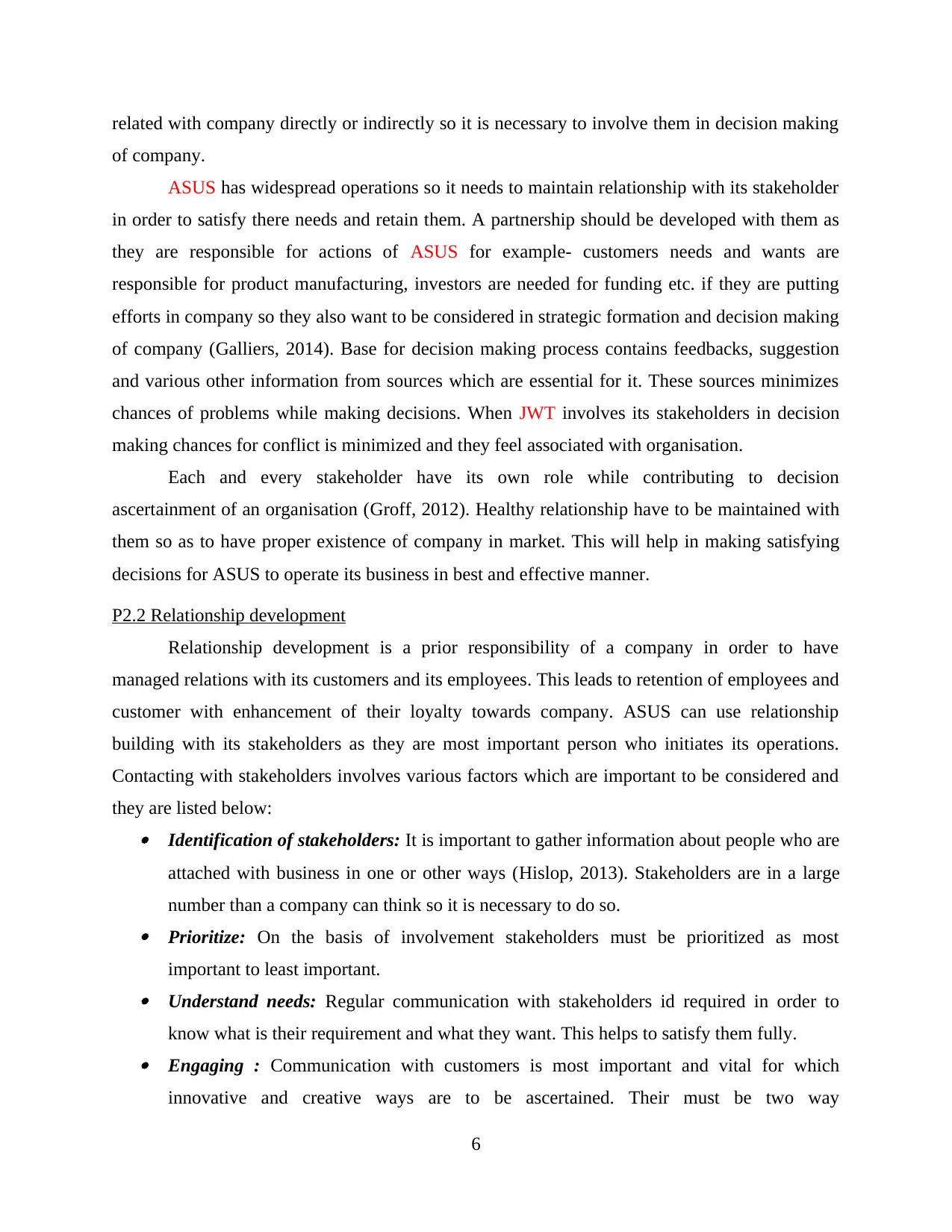
related with company directly or indirectly so it is necessary to involve them in decision making
of company.
ASUS has widespread operations so it needs to maintain relationship with its stakeholder
in order to satisfy there needs and retain them. A partnership should be developed with them as
they are responsible for actions of ASUS for example- customers needs and wants are
responsible for product manufacturing, investors are needed for funding etc. if they are putting
efforts in company so they also want to be considered in strategic formation and decision making
of company (Galliers, 2014). Base for decision making process contains feedbacks, suggestion
and various other information from sources which are essential for it. These sources minimizes
chances of problems while making decisions. When JWT involves its stakeholders in decision
making chances for conflict is minimized and they feel associated with organisation.
Each and every stakeholder have its own role while contributing to decision
ascertainment of an organisation (Groff, 2012). Healthy relationship have to be maintained with
them so as to have proper existence of company in market. This will help in making satisfying
decisions for ASUS to operate its business in best and effective manner.
P2.2 Relationship development
Relationship development is a prior responsibility of a company in order to have
managed relations with its customers and its employees. This leads to retention of employees and
customer with enhancement of their loyalty towards company. ASUS can use relationship
building with its stakeholders as they are most important person who initiates its operations.
Contacting with stakeholders involves various factors which are important to be considered and
they are listed below: Identification of stakeholders: It is important to gather information about people who are
attached with business in one or other ways (Hislop, 2013). Stakeholders are in a large
number than a company can think so it is necessary to do so. Prioritize: On the basis of involvement stakeholders must be prioritized as most
important to least important. Understand needs: Regular communication with stakeholders id required in order to
know what is their requirement and what they want. This helps to satisfy them fully. Engaging : Communication with customers is most important and vital for which
innovative and creative ways are to be ascertained. Their must be two way
6
of company.
ASUS has widespread operations so it needs to maintain relationship with its stakeholder
in order to satisfy there needs and retain them. A partnership should be developed with them as
they are responsible for actions of ASUS for example- customers needs and wants are
responsible for product manufacturing, investors are needed for funding etc. if they are putting
efforts in company so they also want to be considered in strategic formation and decision making
of company (Galliers, 2014). Base for decision making process contains feedbacks, suggestion
and various other information from sources which are essential for it. These sources minimizes
chances of problems while making decisions. When JWT involves its stakeholders in decision
making chances for conflict is minimized and they feel associated with organisation.
Each and every stakeholder have its own role while contributing to decision
ascertainment of an organisation (Groff, 2012). Healthy relationship have to be maintained with
them so as to have proper existence of company in market. This will help in making satisfying
decisions for ASUS to operate its business in best and effective manner.
P2.2 Relationship development
Relationship development is a prior responsibility of a company in order to have
managed relations with its customers and its employees. This leads to retention of employees and
customer with enhancement of their loyalty towards company. ASUS can use relationship
building with its stakeholders as they are most important person who initiates its operations.
Contacting with stakeholders involves various factors which are important to be considered and
they are listed below: Identification of stakeholders: It is important to gather information about people who are
attached with business in one or other ways (Hislop, 2013). Stakeholders are in a large
number than a company can think so it is necessary to do so. Prioritize: On the basis of involvement stakeholders must be prioritized as most
important to least important. Understand needs: Regular communication with stakeholders id required in order to
know what is their requirement and what they want. This helps to satisfy them fully. Engaging : Communication with customers is most important and vital for which
innovative and creative ways are to be ascertained. Their must be two way
6
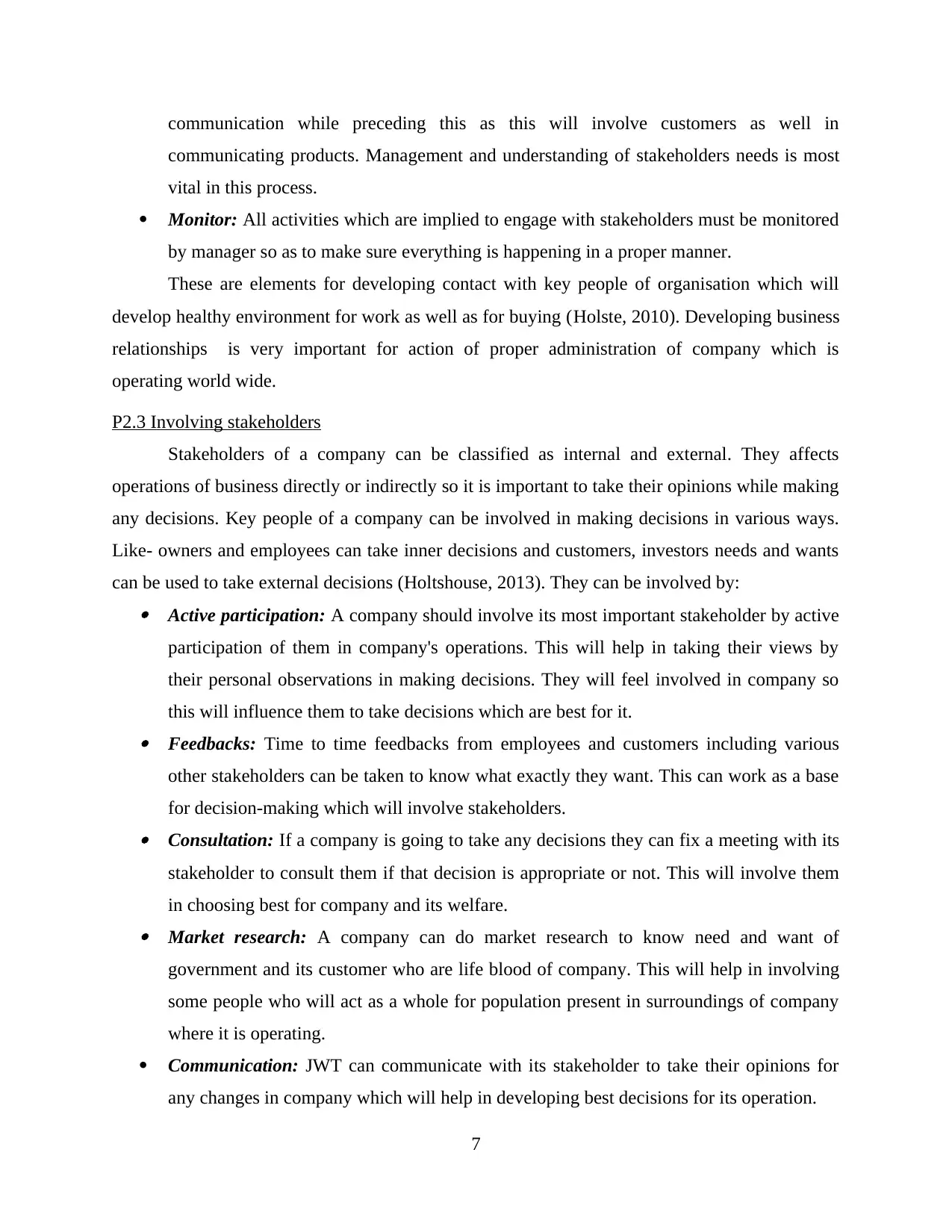
communication while preceding this as this will involve customers as well in
communicating products. Management and understanding of stakeholders needs is most
vital in this process.
Monitor: All activities which are implied to engage with stakeholders must be monitored
by manager so as to make sure everything is happening in a proper manner.
These are elements for developing contact with key people of organisation which will
develop healthy environment for work as well as for buying (Holste, 2010). Developing business
relationships is very important for action of proper administration of company which is
operating world wide.
P2.3 Involving stakeholders
Stakeholders of a company can be classified as internal and external. They affects
operations of business directly or indirectly so it is important to take their opinions while making
any decisions. Key people of a company can be involved in making decisions in various ways.
Like- owners and employees can take inner decisions and customers, investors needs and wants
can be used to take external decisions (Holtshouse, 2013). They can be involved by: Active participation: A company should involve its most important stakeholder by active
participation of them in company's operations. This will help in taking their views by
their personal observations in making decisions. They will feel involved in company so
this will influence them to take decisions which are best for it. Feedbacks: Time to time feedbacks from employees and customers including various
other stakeholders can be taken to know what exactly they want. This can work as a base
for decision-making which will involve stakeholders. Consultation: If a company is going to take any decisions they can fix a meeting with its
stakeholder to consult them if that decision is appropriate or not. This will involve them
in choosing best for company and its welfare. Market research: A company can do market research to know need and want of
government and its customer who are life blood of company. This will help in involving
some people who will act as a whole for population present in surroundings of company
where it is operating.
Communication: JWT can communicate with its stakeholder to take their opinions for
any changes in company which will help in developing best decisions for its operation.
7
communicating products. Management and understanding of stakeholders needs is most
vital in this process.
Monitor: All activities which are implied to engage with stakeholders must be monitored
by manager so as to make sure everything is happening in a proper manner.
These are elements for developing contact with key people of organisation which will
develop healthy environment for work as well as for buying (Holste, 2010). Developing business
relationships is very important for action of proper administration of company which is
operating world wide.
P2.3 Involving stakeholders
Stakeholders of a company can be classified as internal and external. They affects
operations of business directly or indirectly so it is important to take their opinions while making
any decisions. Key people of a company can be involved in making decisions in various ways.
Like- owners and employees can take inner decisions and customers, investors needs and wants
can be used to take external decisions (Holtshouse, 2013). They can be involved by: Active participation: A company should involve its most important stakeholder by active
participation of them in company's operations. This will help in taking their views by
their personal observations in making decisions. They will feel involved in company so
this will influence them to take decisions which are best for it. Feedbacks: Time to time feedbacks from employees and customers including various
other stakeholders can be taken to know what exactly they want. This can work as a base
for decision-making which will involve stakeholders. Consultation: If a company is going to take any decisions they can fix a meeting with its
stakeholder to consult them if that decision is appropriate or not. This will involve them
in choosing best for company and its welfare. Market research: A company can do market research to know need and want of
government and its customer who are life blood of company. This will help in involving
some people who will act as a whole for population present in surroundings of company
where it is operating.
Communication: JWT can communicate with its stakeholder to take their opinions for
any changes in company which will help in developing best decisions for its operation.
7
⊘ This is a preview!⊘
Do you want full access?
Subscribe today to unlock all pages.

Trusted by 1+ million students worldwide
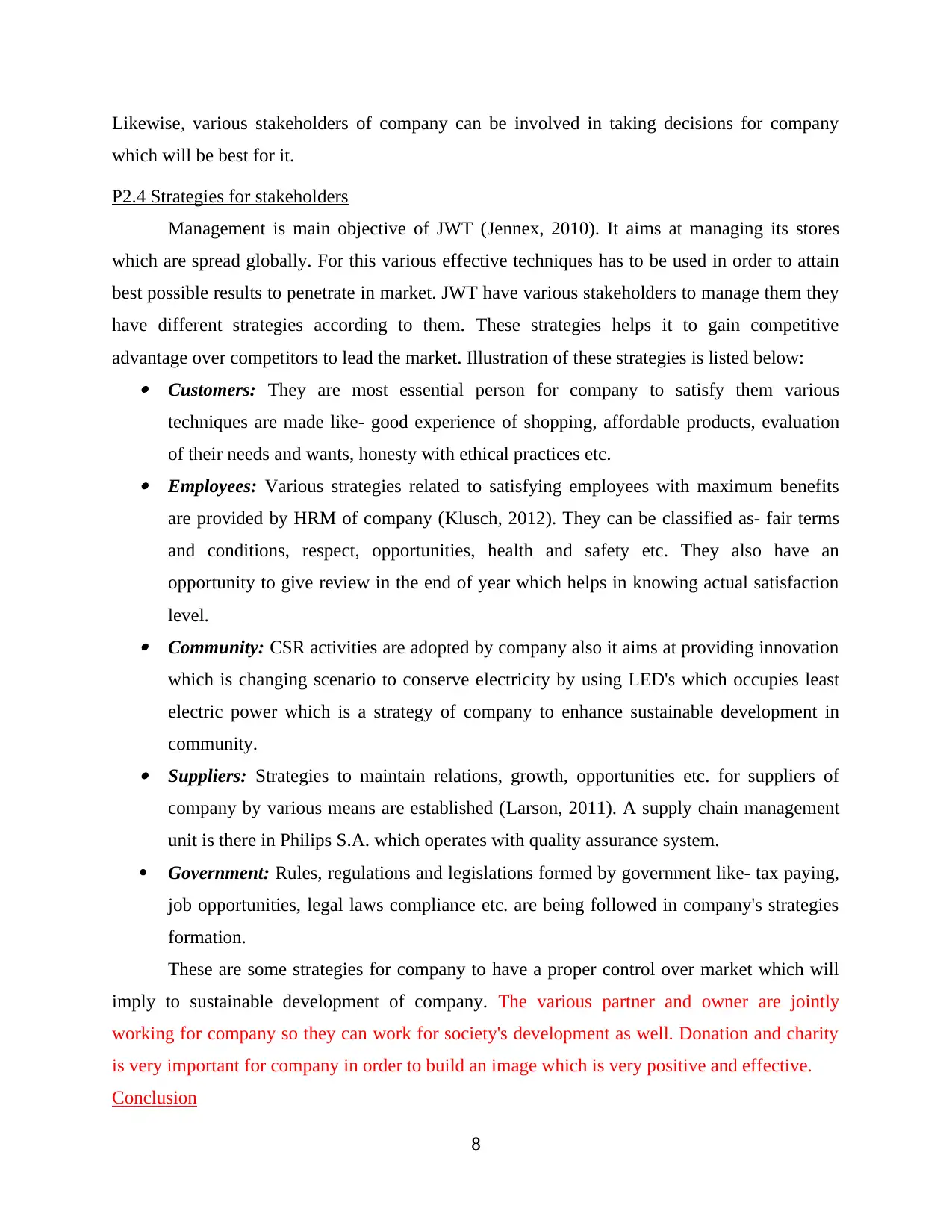
Likewise, various stakeholders of company can be involved in taking decisions for company
which will be best for it.
P2.4 Strategies for stakeholders
Management is main objective of JWT (Jennex, 2010). It aims at managing its stores
which are spread globally. For this various effective techniques has to be used in order to attain
best possible results to penetrate in market. JWT have various stakeholders to manage them they
have different strategies according to them. These strategies helps it to gain competitive
advantage over competitors to lead the market. Illustration of these strategies is listed below: Customers: They are most essential person for company to satisfy them various
techniques are made like- good experience of shopping, affordable products, evaluation
of their needs and wants, honesty with ethical practices etc. Employees: Various strategies related to satisfying employees with maximum benefits
are provided by HRM of company (Klusch, 2012). They can be classified as- fair terms
and conditions, respect, opportunities, health and safety etc. They also have an
opportunity to give review in the end of year which helps in knowing actual satisfaction
level. Community: CSR activities are adopted by company also it aims at providing innovation
which is changing scenario to conserve electricity by using LED's which occupies least
electric power which is a strategy of company to enhance sustainable development in
community. Suppliers: Strategies to maintain relations, growth, opportunities etc. for suppliers of
company by various means are established (Larson, 2011). A supply chain management
unit is there in Philips S.A. which operates with quality assurance system.
Government: Rules, regulations and legislations formed by government like- tax paying,
job opportunities, legal laws compliance etc. are being followed in company's strategies
formation.
These are some strategies for company to have a proper control over market which will
imply to sustainable development of company. The various partner and owner are jointly
working for company so they can work for society's development as well. Donation and charity
is very important for company in order to build an image which is very positive and effective.
Conclusion
8
which will be best for it.
P2.4 Strategies for stakeholders
Management is main objective of JWT (Jennex, 2010). It aims at managing its stores
which are spread globally. For this various effective techniques has to be used in order to attain
best possible results to penetrate in market. JWT have various stakeholders to manage them they
have different strategies according to them. These strategies helps it to gain competitive
advantage over competitors to lead the market. Illustration of these strategies is listed below: Customers: They are most essential person for company to satisfy them various
techniques are made like- good experience of shopping, affordable products, evaluation
of their needs and wants, honesty with ethical practices etc. Employees: Various strategies related to satisfying employees with maximum benefits
are provided by HRM of company (Klusch, 2012). They can be classified as- fair terms
and conditions, respect, opportunities, health and safety etc. They also have an
opportunity to give review in the end of year which helps in knowing actual satisfaction
level. Community: CSR activities are adopted by company also it aims at providing innovation
which is changing scenario to conserve electricity by using LED's which occupies least
electric power which is a strategy of company to enhance sustainable development in
community. Suppliers: Strategies to maintain relations, growth, opportunities etc. for suppliers of
company by various means are established (Larson, 2011). A supply chain management
unit is there in Philips S.A. which operates with quality assurance system.
Government: Rules, regulations and legislations formed by government like- tax paying,
job opportunities, legal laws compliance etc. are being followed in company's strategies
formation.
These are some strategies for company to have a proper control over market which will
imply to sustainable development of company. The various partner and owner are jointly
working for company so they can work for society's development as well. Donation and charity
is very important for company in order to build an image which is very positive and effective.
Conclusion
8
Paraphrase This Document
Need a fresh take? Get an instant paraphrase of this document with our AI Paraphraser
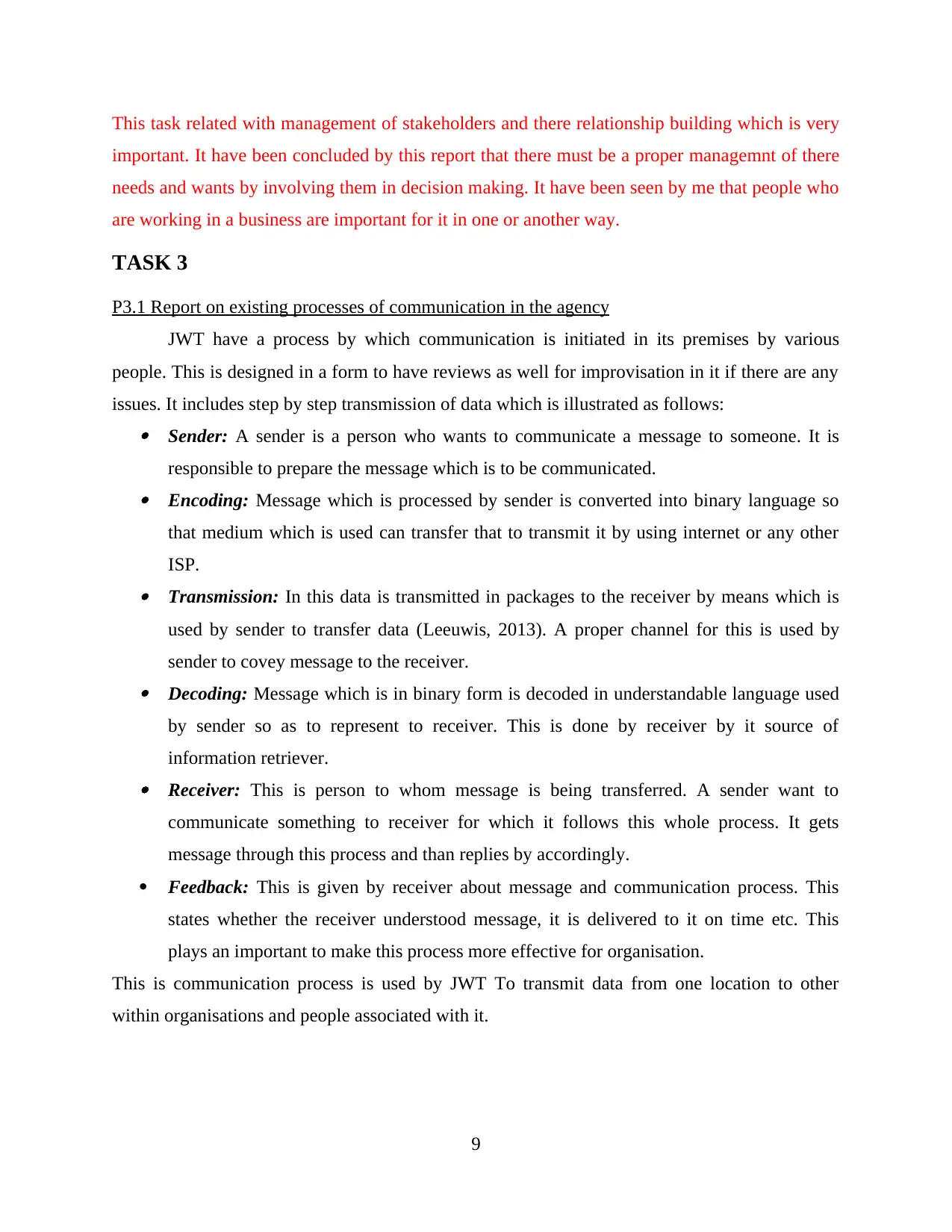
This task related with management of stakeholders and there relationship building which is very
important. It have been concluded by this report that there must be a proper managemnt of there
needs and wants by involving them in decision making. It have been seen by me that people who
are working in a business are important for it in one or another way.
TASK 3
P3.1 Report on existing processes of communication in the agency
JWT have a process by which communication is initiated in its premises by various
people. This is designed in a form to have reviews as well for improvisation in it if there are any
issues. It includes step by step transmission of data which is illustrated as follows: Sender: A sender is a person who wants to communicate a message to someone. It is
responsible to prepare the message which is to be communicated. Encoding: Message which is processed by sender is converted into binary language so
that medium which is used can transfer that to transmit it by using internet or any other
ISP. Transmission: In this data is transmitted in packages to the receiver by means which is
used by sender to transfer data (Leeuwis, 2013). A proper channel for this is used by
sender to covey message to the receiver. Decoding: Message which is in binary form is decoded in understandable language used
by sender so as to represent to receiver. This is done by receiver by it source of
information retriever. Receiver: This is person to whom message is being transferred. A sender want to
communicate something to receiver for which it follows this whole process. It gets
message through this process and than replies by accordingly.
Feedback: This is given by receiver about message and communication process. This
states whether the receiver understood message, it is delivered to it on time etc. This
plays an important to make this process more effective for organisation.
This is communication process is used by JWT To transmit data from one location to other
within organisations and people associated with it.
9
important. It have been concluded by this report that there must be a proper managemnt of there
needs and wants by involving them in decision making. It have been seen by me that people who
are working in a business are important for it in one or another way.
TASK 3
P3.1 Report on existing processes of communication in the agency
JWT have a process by which communication is initiated in its premises by various
people. This is designed in a form to have reviews as well for improvisation in it if there are any
issues. It includes step by step transmission of data which is illustrated as follows: Sender: A sender is a person who wants to communicate a message to someone. It is
responsible to prepare the message which is to be communicated. Encoding: Message which is processed by sender is converted into binary language so
that medium which is used can transfer that to transmit it by using internet or any other
ISP. Transmission: In this data is transmitted in packages to the receiver by means which is
used by sender to transfer data (Leeuwis, 2013). A proper channel for this is used by
sender to covey message to the receiver. Decoding: Message which is in binary form is decoded in understandable language used
by sender so as to represent to receiver. This is done by receiver by it source of
information retriever. Receiver: This is person to whom message is being transferred. A sender want to
communicate something to receiver for which it follows this whole process. It gets
message through this process and than replies by accordingly.
Feedback: This is given by receiver about message and communication process. This
states whether the receiver understood message, it is delivered to it on time etc. This
plays an important to make this process more effective for organisation.
This is communication process is used by JWT To transmit data from one location to other
within organisations and people associated with it.
9
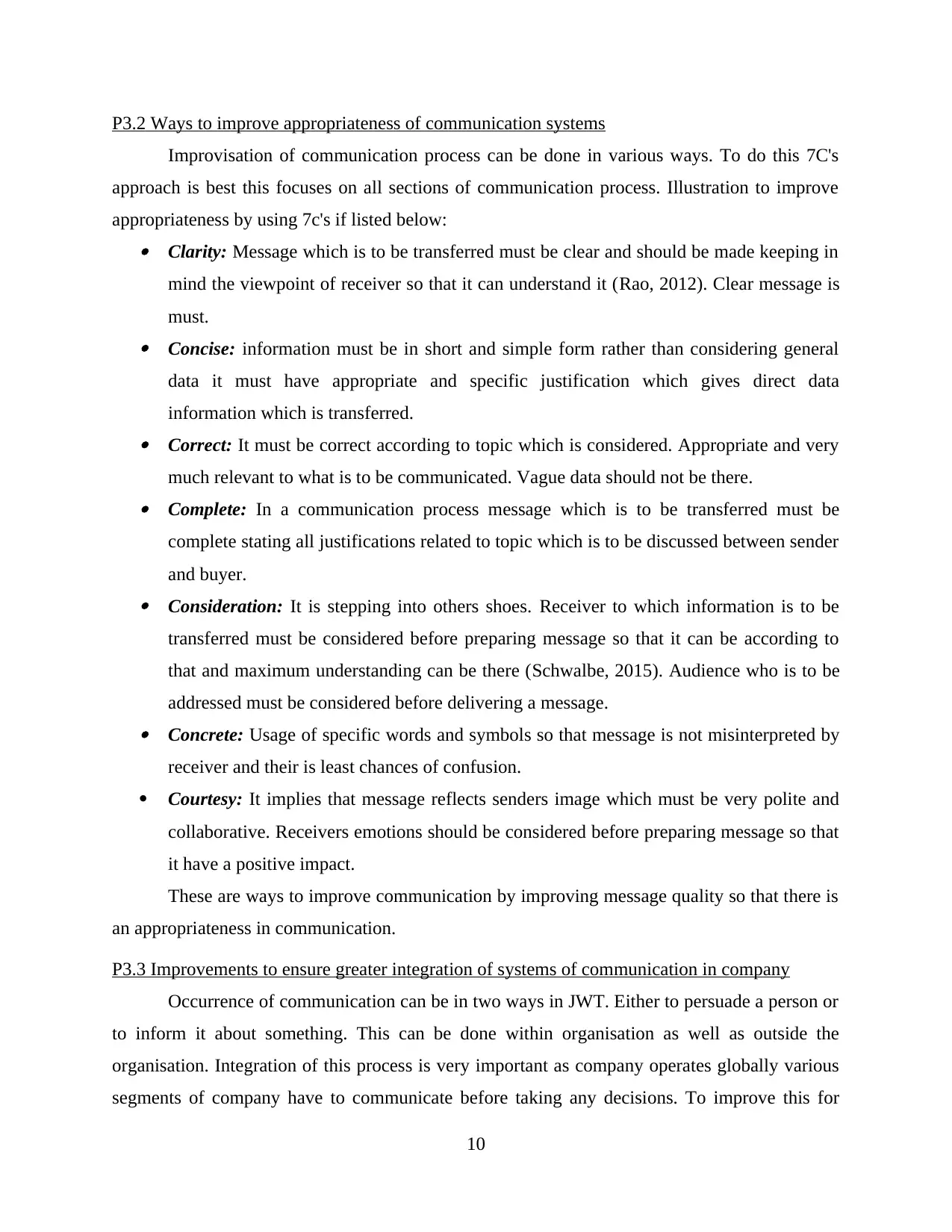
P3.2 Ways to improve appropriateness of communication systems
Improvisation of communication process can be done in various ways. To do this 7C's
approach is best this focuses on all sections of communication process. Illustration to improve
appropriateness by using 7c's if listed below: Clarity: Message which is to be transferred must be clear and should be made keeping in
mind the viewpoint of receiver so that it can understand it (Rao, 2012). Clear message is
must. Concise: information must be in short and simple form rather than considering general
data it must have appropriate and specific justification which gives direct data
information which is transferred. Correct: It must be correct according to topic which is considered. Appropriate and very
much relevant to what is to be communicated. Vague data should not be there. Complete: In a communication process message which is to be transferred must be
complete stating all justifications related to topic which is to be discussed between sender
and buyer. Consideration: It is stepping into others shoes. Receiver to which information is to be
transferred must be considered before preparing message so that it can be according to
that and maximum understanding can be there (Schwalbe, 2015). Audience who is to be
addressed must be considered before delivering a message. Concrete: Usage of specific words and symbols so that message is not misinterpreted by
receiver and their is least chances of confusion.
Courtesy: It implies that message reflects senders image which must be very polite and
collaborative. Receivers emotions should be considered before preparing message so that
it have a positive impact.
These are ways to improve communication by improving message quality so that there is
an appropriateness in communication.
P3.3 Improvements to ensure greater integration of systems of communication in company
Occurrence of communication can be in two ways in JWT. Either to persuade a person or
to inform it about something. This can be done within organisation as well as outside the
organisation. Integration of this process is very important as company operates globally various
segments of company have to communicate before taking any decisions. To improve this for
10
Improvisation of communication process can be done in various ways. To do this 7C's
approach is best this focuses on all sections of communication process. Illustration to improve
appropriateness by using 7c's if listed below: Clarity: Message which is to be transferred must be clear and should be made keeping in
mind the viewpoint of receiver so that it can understand it (Rao, 2012). Clear message is
must. Concise: information must be in short and simple form rather than considering general
data it must have appropriate and specific justification which gives direct data
information which is transferred. Correct: It must be correct according to topic which is considered. Appropriate and very
much relevant to what is to be communicated. Vague data should not be there. Complete: In a communication process message which is to be transferred must be
complete stating all justifications related to topic which is to be discussed between sender
and buyer. Consideration: It is stepping into others shoes. Receiver to which information is to be
transferred must be considered before preparing message so that it can be according to
that and maximum understanding can be there (Schwalbe, 2015). Audience who is to be
addressed must be considered before delivering a message. Concrete: Usage of specific words and symbols so that message is not misinterpreted by
receiver and their is least chances of confusion.
Courtesy: It implies that message reflects senders image which must be very polite and
collaborative. Receivers emotions should be considered before preparing message so that
it have a positive impact.
These are ways to improve communication by improving message quality so that there is
an appropriateness in communication.
P3.3 Improvements to ensure greater integration of systems of communication in company
Occurrence of communication can be in two ways in JWT. Either to persuade a person or
to inform it about something. This can be done within organisation as well as outside the
organisation. Integration of this process is very important as company operates globally various
segments of company have to communicate before taking any decisions. To improve this for
10
⊘ This is a preview!⊘
Do you want full access?
Subscribe today to unlock all pages.

Trusted by 1+ million students worldwide
1 out of 20
Related Documents
Your All-in-One AI-Powered Toolkit for Academic Success.
+13062052269
info@desklib.com
Available 24*7 on WhatsApp / Email
![[object Object]](/_next/static/media/star-bottom.7253800d.svg)
Unlock your academic potential
Copyright © 2020–2025 A2Z Services. All Rights Reserved. Developed and managed by ZUCOL.





